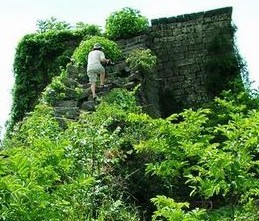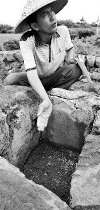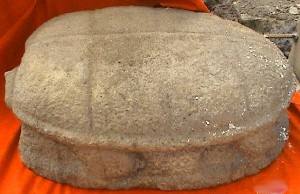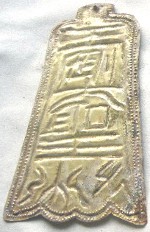Chinese archaeologists working at an ancient stone pagoda in Hainan Province (海南省) recently made a discovery which will help to establish the date when the pagoda was originally built.
An article in the October 27, 2011 edition of the Haikou Evening News (海口晚报) describes the restoration work being done at the Rufu Stone Pagoda (儒符石塔) near Haikou. The pagoda is distinctive because it is built from volcanic rock but has fallen into disrepair over the centuries.
Few records exist concerning the history of the pagoda with the oldest references dating to the Ming Dynasty.
The pagoda is believed to have been built during the late Song Dynasty but no historical evidence exists to prove this.
The Buddhist pagoda is one of the oldest structures in the province and its design reflects Indian influences.
While working at the base of the pagoda a worker discovered a hidden vault.
Inside the vault was a stone tortoise-shaped box.
According to Mr. Wang Daxin (王大新), the Director of the Haikou City Bureau of Cultural Relics (海口市文物局), the tortoise box contained a number of items.
In the box were more that seventy Chinese bronze coins. Remarkably, the coins still retain remnants of the cord with which they had been bound together.
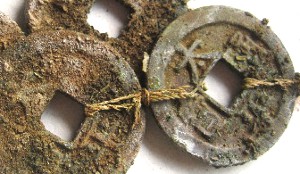
The majority of the coins have the inscription tai ping tong bao (太平通宝) which means they were cast during the years 976-989 of the reign of Emperor Tai Zong of the Song Dynasty.
Coins are always considered an important find because they can be accurately dated. Since the majority of the coins are tai ping tong bao, it is most likely that the pagoda was built during this same time period.
Among the most puzzling artifacts found in the box, however, were six metal tablets. Originally thought to be made of tin, after cleaning they were found to be made of silver. Unfortunately, three of the tablets were too fragile to be cleaned so they are being kept in their original state. This also means that their inscriptions cannot be read.
Of the other three silver tablets, two have auspicious connotations. One has the inscription fu de chang shou (福德长寿) which translates as “good fortune, virtue and a long life”. Another has the inscription qian yuan heng li zhen (乾元亨利贞) which is a cryptic phrase from the ancient Chinese “Book of Changes” (I Ching 易经).
The last silver tablet, displayed above, has the inscription wang gang da sheng (王刚大圣). The experts are still trying to understand the meaning of this inscription.
Mr. Wang made clear that while the archaeologists continue to study the cultural relics found at the site, the work to restore the pagoda to its original state is continuing with completion of the project expected by the end of this year.
